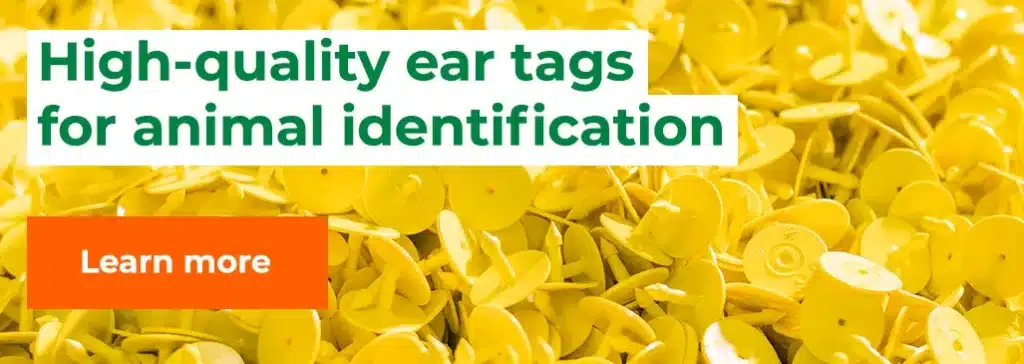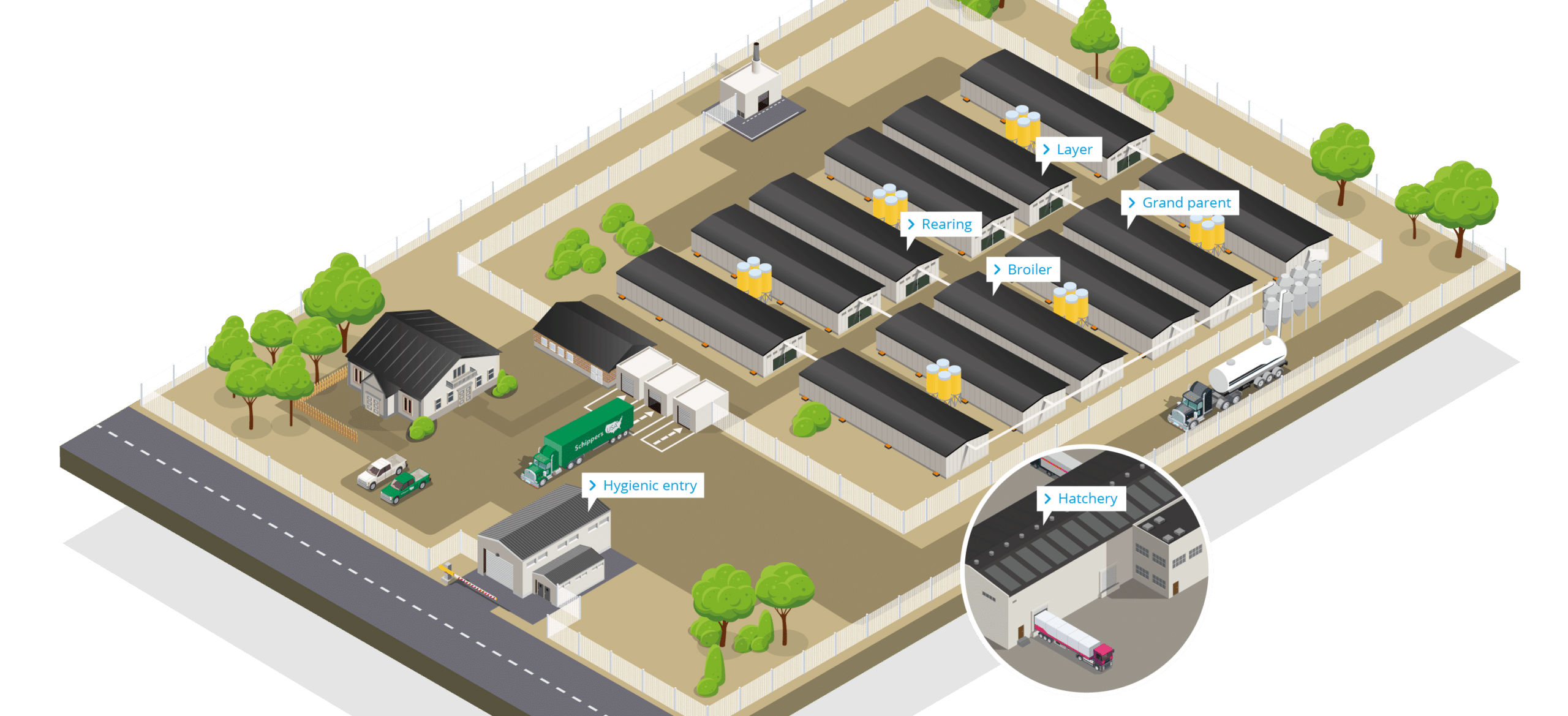
Hatchery
The hatchery is a specialized facility in the poultry industry where fertile eggs are incubated under controlled conditions to hatch into chicks.
Rearing
Rearing farms providing optimal conditions that promote the healthy growth and preparation of the young birds for their future roles as egg-laying hens or broilers.
Broiler
A broiler farm is dedicated to raising chickens specifically for meat production. The chickens in these farms are known as broilers. These farms focus on efficiently producing chickens that reach market weight within a relatively short period, typically around 5 to 7 weeks, depending on the desired size, market preferences and regulations.
Grand parent
A grandparent (GP) farm, also known as a grandparent stock farm, is a specialized facility in the poultry industry that is dedicated to breeding and producing the initial generation of breeding birds. These breeding birds serve as the foundation for the production of parent stock, which in turn produces the commercial broilers or layers that are raised for meat or egg production.
Layer
A layer farm is dedicated to raising hens specifically for egg production. In a layer farm, the primary focus is on maximizing egg production while maintaining the health and well-being of the laying hens. These hens are referred to as "layers" because they are raised primarily to lay eggs that are collected for human consumption.
Hygienic entry
The hygienic entry area at a poultry farm refers to a controlled and designated zone where individuals, including farm workers, visitors, and service providers, must adhere to specific hygiene protocols before entering the main production area of the farm.
Biosecurity programsfor poultry farms
Hatchery
What’s important at the hatchery?
Controlling cross-contamination is of utmost importance at the hatchery. If any disease or pathogen is introduced into a hatchery, it can quickly spread to other parts of the production chain, including broiler farms, layer farms, and processing facilities. Therefore, maintaining proper biosecurity measures at the hatchery is crucial to ensure productivity and prevent any potential loss throughout the chain.

Common challenges
- External disease introduction: Introducing infectious agents, such as viruses or bacteria, into the hatchery can affect the entire supply chain.
- Internal cross-contamination: Hatcheries handle eggs and chicks from different sources, risking cross-contamination between batches.
- Inadequate cleaning and disinfection: Insufficient C&D practices of tools and equipment can allow pathogens to survive and spread
- Personnel hygiene and training: Lack of proper training and hygiene practices among hatchery staff can lead to the inadvertent spread of diseases.
Cleaning and disinfection inside hatcheries
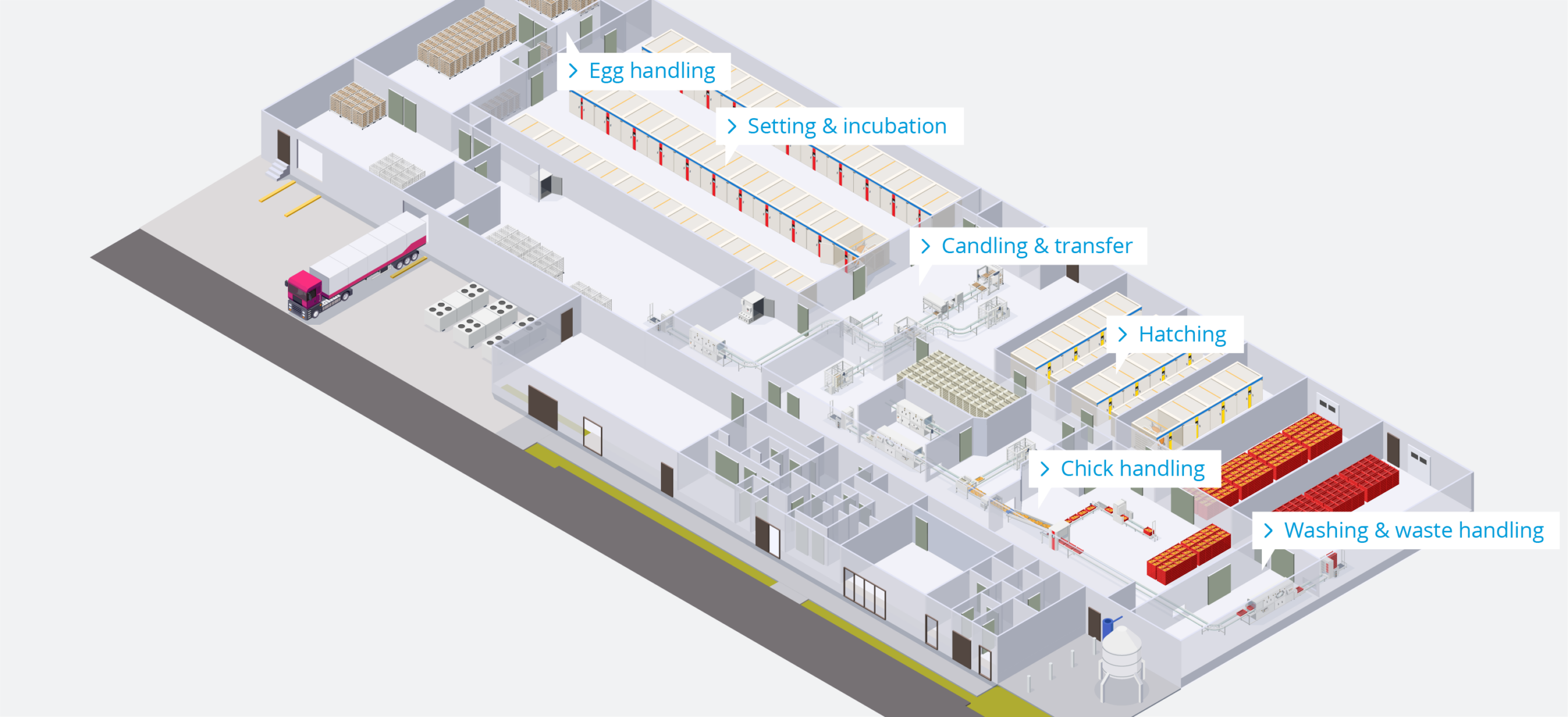
Cleaning and disinfection at the egg handling area
Egg handling at a hatchery involves carefully collecting, inspecting, and preparing eggs for incubation.
Proper egg handling, cleaning, and disinfection practices are essential to prevent the transmission of diseases and maintain a clean and controlled environment for optimal hatch rates. Cleaning and disinfection during egg arrival and handling in hatcheries include:
Cleaning Process:
- Initial Inspection: Eggs are visually inspected upon arrival to identify and remove visibly soiled or damaged eggs.
- Dry Cleaning: Dust, feathers, and other debris are removed from the egg surfaces using soft brushes, air blowers, or vacuum systems.
- Wet Cleaning (Optional): Some hatcheries wash eggs with a mild detergent solution or a specially formulated egg cleaner. However, this step is generally avoided to prevent moisture from penetrating the eggshell, which could increase the risk of microbial contamination.
Disinfection Process:
- Sanitizing Solution: A disinfectant solution approved for eggshell sanitization is applied, usually through a fine mist or spray. It’s important to use safe disinfectants for the embryos and not leave harmful residues.
- Drying: After applying the disinfectant, eggs are left to dry. Drying helps eliminate excess moisture and prevents the growth of microorganisms.
- Fumigation (Optional): Some hatcheries use fumigation with safe and approved gases to further reduce microbial load.

Cleaning and disinfection at setting and incubation
Setting and incubation are vital stages in a hatchery’s process. They create the controlled environment necessary for healthy embryo development and successful hatching.
Cleaning and disinfecting incubators in hatcheries are crucial processes to creating a clean and pathogen-free environment for developing embryos. Proper incubator maintenance ensures optimal hatch rates and the production of healthy chicks.
Cleaning Process:
- Preparation: Power off and unplug the incubator. Remove eggs and accessories.
- Dry Cleaning: Use soft brushes, cloths, or vacuum systems to remove dust and debris from interior and exterior surfaces.
- Residue Removal: Gently eliminate stubborn residues without causing damage using a suitable foam cleaner agent, cleaning prepares the surface for disinfection
- Air Circulation: Allow the incubator to air out to reduce moisture content.
Disinfection Process:
- Choose a Disinfectant: Use an approved disinfectant that is effective against various pathogens.
- Prepare Solution: Follow the instructions to prepare the disinfectant solution and wear appropriate PPE.
- Apply Disinfectant: Ensure thorough coverage of all incubator surfaces, avoiding oversaturation.
- Contact Time: Allow the disinfectant to sit for the recommended duration.
- Rinsing (If Needed): Some disinfectants require rinsing, which should be done using clean water.
- Drying: Thoroughly dry the incubator to prevent microbial growth and electrical issues.
- Post-Disinfection Checks: Before reassembling, ensure surfaces are dry and free of residual disinfectant.
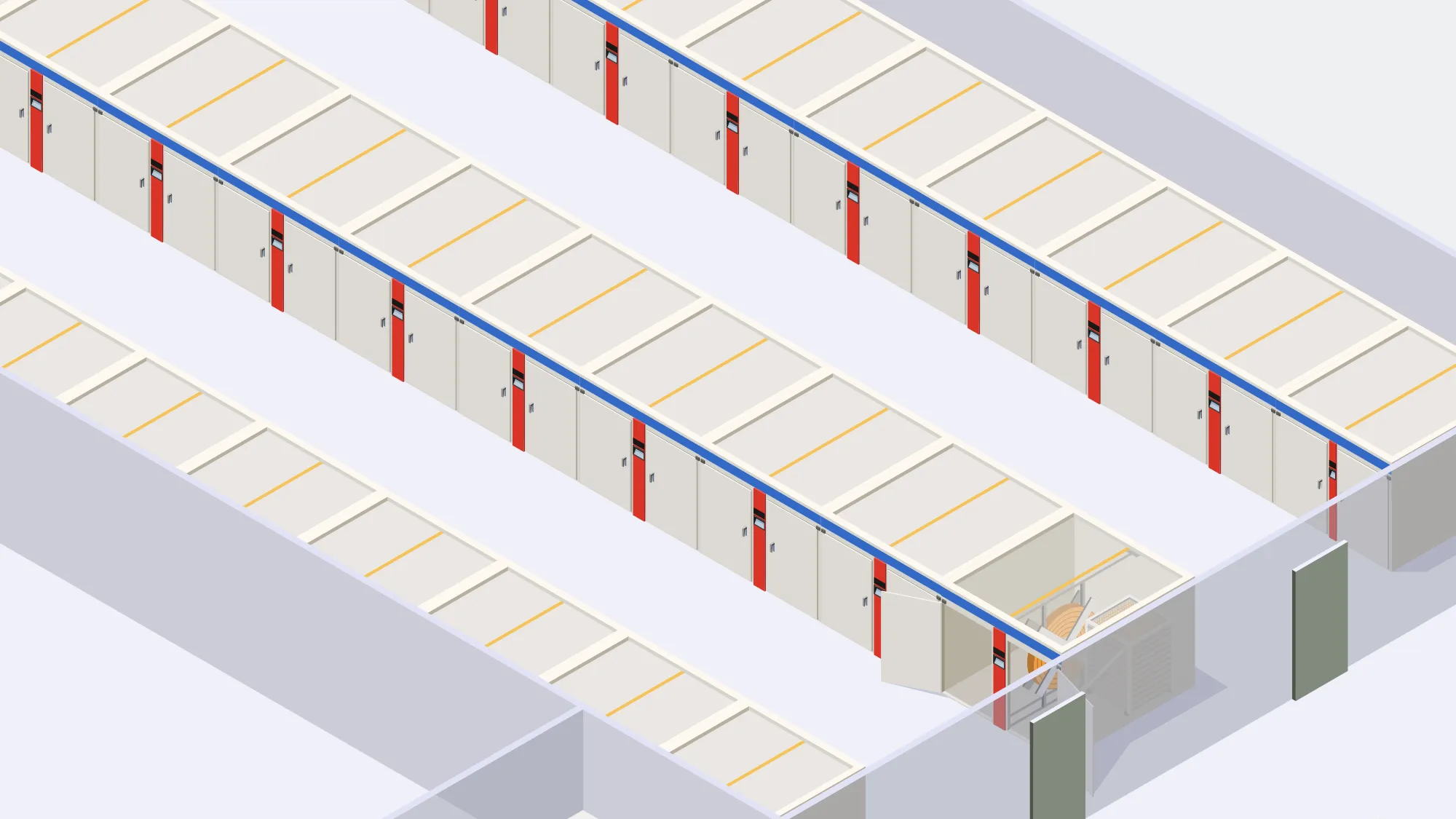
Cleaning and disinfection at candling and transfer
Candling equipment examines the developing embryos inside eggs to determine their viability, while transfer equipment moves eggs between different stages of incubation. Keeping these tools clean and disinfected is crucial to prevent contamination and ensure the health of the embryos.
Cleaning Process:
- Preparation: Ensure all equipment is powered off and disconnected from power sources before cleaning.
- Disassembly: Disassemble the candling and transfer equipment according to manufacturer guidelines to access all parts and components.
- Dry Cleaning: Use soft brushes, cloths, or vacuum systems to remove dust, dirt, and debris from all surfaces, nooks, and crannies of the equipment.
- Cleaning Agents: Use mild detergents that are suitable for the equipment. Avoid harsh chemicals that might damage the equipment or leave harmful residues.
- Cleaning Brushes: Use soft brushes, microfiber cloths, or non-abrasive scrubbing pads to clean surfaces. Avoid abrasive materials that could scratch or damage equipment.
- Rinsing: If using cleaning agents, ensure thorough rinsing with clean water to remove any detergent residue. Proper rinsing prevents contamination of the embryos.
- Drying: Allow all components to dry completely before reassembly. Proper drying prevents the growth of microorganisms.
Disinfecting Process:
- Select Safe Disinfectant: Use an approved disinfectant that is safe for equipment and hatchery use.
- Prepare Solution: Follow instructions to create the right dilution and wear PPE.
- Apply Disinfectant: Ensure full coverage of equipment surfaces.
- Contact Time: Let the disinfectant sit for the recommended time.
- Rinsing (If Required): Rinse with clean water if instructed by the disinfectant guidelines.
- Drying: Allow equipment to air dry before use.

Cleaning and disinfection of the hatchers
The hatching phase is a critical culmination of the incubation process, where carefully nurtured embryos transition into healthy chicks.
Cleaning and disinfection of hatching areas is essential to create a clean and pathogen-free environment for the new hatching chicks.
Preparation:
- Clear the Area: Remove all equipment, trays, and materials from the hatching room to ensure thorough cleaning.
- Ventilation: Ensure proper ventilation by opening windows or using fans to allow fresh air circulation.
Cleaning Process:
- Dry Cleaning: Start by removing dust, debris, and any loose particles from surfaces, walls, floors, and ceilings using soft brushes, brooms, or vacuum systems.
- Wet Cleaning: Use mild detergents or cleaning solutions approved for hatchery use to clean surfaces. Pay attention to areas prone to contamination, such as corners and crevices.
- Tools: For dry cleaning use non-abrasive brushes. For wet cleaning sponges, mobs and pressure washes (when appropriate) can be used. Avoid abrasive materials that might damage surfaces.
- Rinsing: After cleaning with detergents, rinse all surfaces with clean water to remove any residue.
- Drying: Ensure proper drying of all surfaces, as excess moisture can encourage the growth of microorganisms.
Disinfection Process:
- Selecting a Disinfectant: Choose a disinfectant that is effective against a wide range of pathogens and approved for use in hatcheries.
- Preparing the Solution: Prepare the disinfectant solution according to the instructions, and wear appropriate PPE, such as gloves and safety goggles.
- Application: Apply the disinfectant solution to all surfaces, including walls, floors, ceilings, and equipment. Ensure thorough coverage.
- Contact Time: Allow the disinfectant to remain in contact with surfaces for the recommended duration specified by the manufacturer.
- Rinsing (If Needed): Some disinfectants require rinsing after contact. If required, use clean water to remove any residual disinfectant.
- Drying: Ensure proper drying of all surfaces before reintroducing equipment and materials.

Cleaning and disinfection at chick handling
Chick handling is a pivotal stage where freshly hatched chicks are carefully managed to ensure their health, well-being, and safe transition.
Cleaning and disinfecting chick handling equipment in hatcheries is crucial to ensuring the health and well-being of the chicks during their early stages of development. Proper hygiene practices minimize the risk of disease transmission and promote optimal chick growth.
Preparation:
- Clearing the Area: Remove chicks, bedding, and any other materials from the chick handling area before starting the cleaning process.
- Safety Measures: Ensure the equipment is powered off and disconnected from power sources to ensure safety during cleaning.
Cleaning Process:
- Dry Cleaning: Use soft brushes, cloths, or vacuum systems to remove visible dirt, debris, and bedding residues from the equipment.
- Wet Cleaning: To clean all surfaces of the chick handling equipment, use mild detergents or specially formulated cleaning solutions approved for hatchery use. To avoid damaging equipment surfaces, use non-abrasive brushes, sponges, or cloths to clean them.
- Rinsing: After cleaning solutions, rinse the equipment thoroughly with clean water to remove any detergent residue.
- Drying: Ensure proper drying of all equipment components to prevent the growth of microorganisms and mould.
Disinfection Process:
- Selecting a Disinfectant: Choose a disinfectant that is safe for both the equipment and the chicks and effective against common hatchery pathogens.
- Preparing the Solution: Follow the instructions to prepare the disinfectant solution and wear appropriate PPE, such as gloves and safety goggles.
- Application: Apply the disinfectant solution to all surfaces of the chick handling equipment, paying extra attention to areas frequently touched or in direct contact with chicks.
- Contact Time: Allow the disinfectant to remain in contact with surfaces for the recommended duration.
- Rinsing (If Required): Some disinfectants might require rinsing after the contact time. If needed, rinse thoroughly with clean water.
- Drying: Ensure proper drying of the equipment to eliminate excess moisture.
Personnel Hygiene:
- Hatchery staff should maintain proper personal hygiene while handling chicks and equipment to prevent contamination.
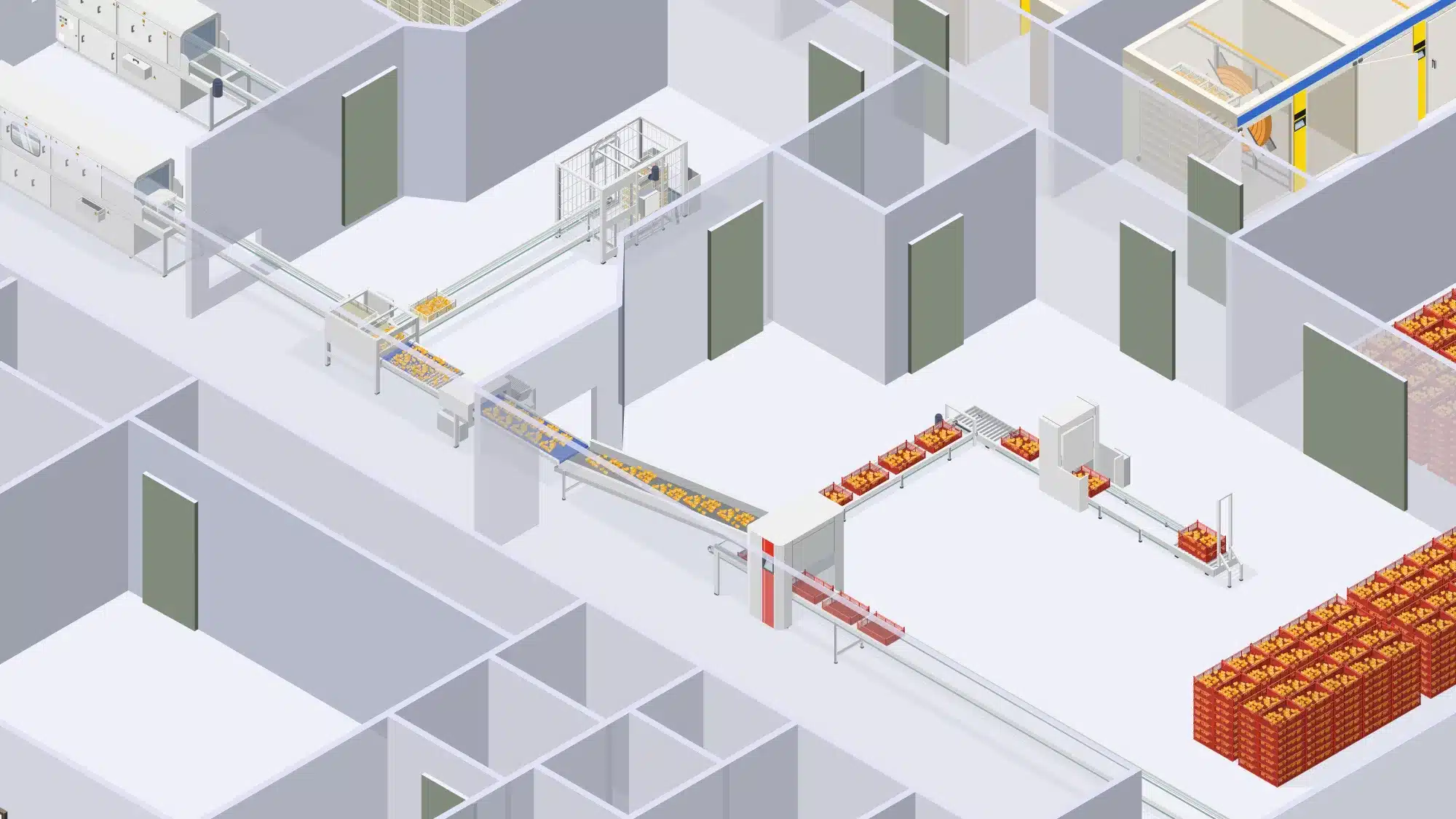
Cleaning and disinfection at the washing and waste handling area
The washing area is where the hatchery’s equipment, trays, and tools are cleaned and sanitized.
Washing Trays and Setters:
- Wash egg trays and setters with detergent solutions to remove organic matter and debris. Ensure thorough cleaning of crevices and corners.
- Rinse trays and setters with clean water to remove detergent residue.
Disinfection:
- Select a disinfectant approved for hatchery use and effective against various pathogens.
- Prepare the disinfectant solution according to manufacturer instructions and wear appropriate PPE.
- Apply the disinfectant solution to all surfaces, equipment, trays, and setters, ensuring comprehensive coverage.
- Allow the disinfectant to remain in contact for the recommended time before rinsing, if necessary.
Biosecurity Measures:
- Implement strict biosecurity protocols to prevent cross-contamination and the spread of pathogens.
- Establish separate areas for cleaning, waste handling, and other hatchery operations to prevent contamination.
Personnel Hygiene:
- To prevent contamination, hatchery staff should follow proper personal hygiene practices, including hand washing and wearing clean protective clothing.
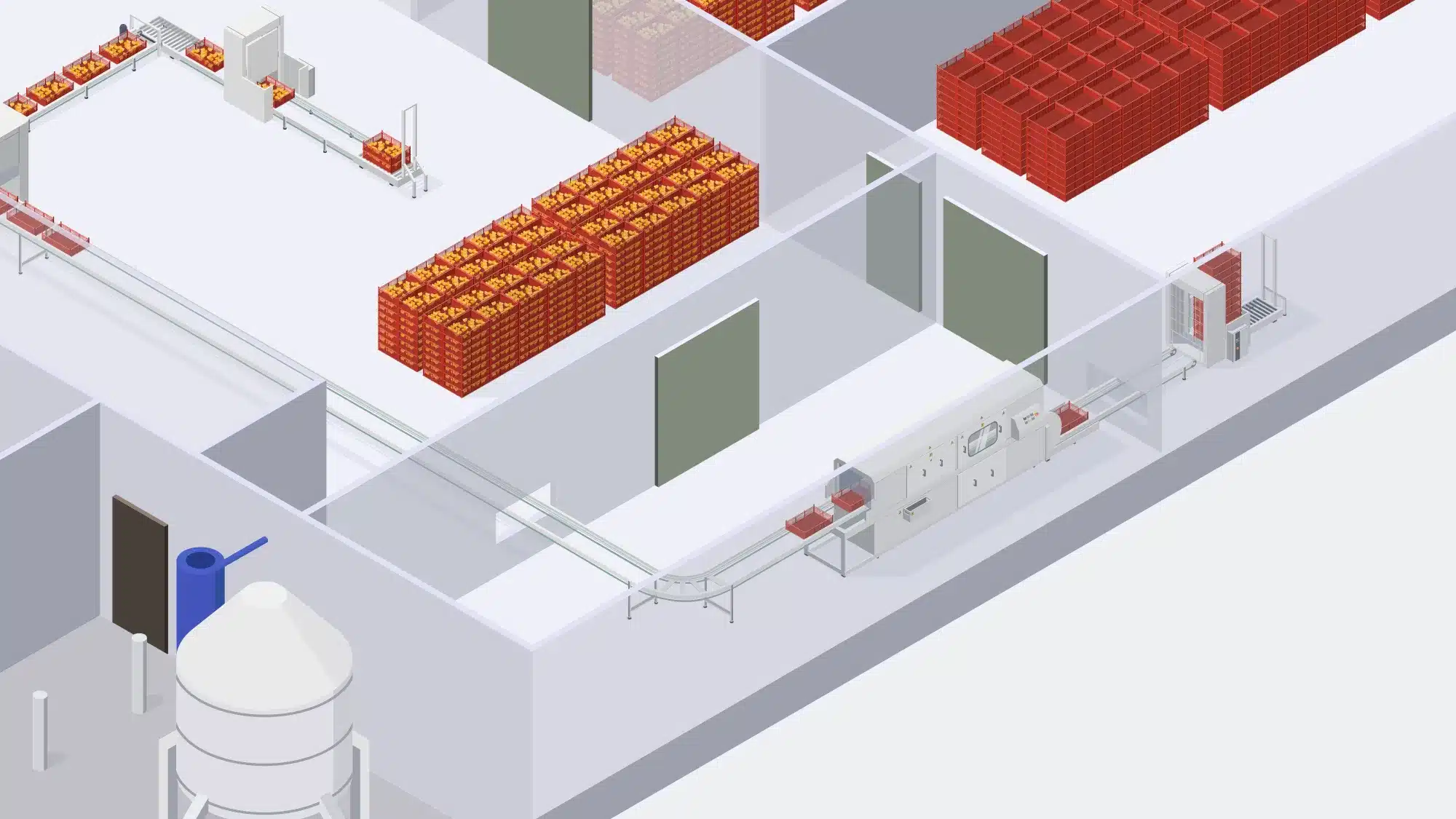
Egg handling at a hatchery involves carefully collecting, inspecting, and preparing eggs for incubation.
Proper egg handling, cleaning, and disinfection practices are essential to prevent the transmission of diseases and maintain a clean and controlled environment for optimal hatch rates. Cleaning and disinfection during egg arrival and handling in hatcheries include:
Cleaning Process:
- Initial Inspection: Eggs are visually inspected upon arrival to identify and remove visibly soiled or damaged eggs.
- Dry Cleaning: Dust, feathers, and other debris are removed from the egg surfaces using soft brushes, air blowers, or vacuum systems.
- Wet Cleaning (Optional): Some hatcheries wash eggs with a mild detergent solution or a specially formulated egg cleaner. However, this step is generally avoided to prevent moisture from penetrating the eggshell, which could increase the risk of microbial contamination.
Disinfection Process:
- Sanitizing Solution: A disinfectant solution approved for eggshell sanitization is applied, usually through a fine mist or spray. It’s important to use safe disinfectants for the embryos and not leave harmful residues.
- Drying: After applying the disinfectant, eggs are left to dry. Drying helps eliminate excess moisture and prevents the growth of microorganisms.
- Fumigation (Optional): Some hatcheries use fumigation with safe and approved gases to further reduce microbial load.

Setting and incubation are vital stages in a hatchery’s process. They create the controlled environment necessary for healthy embryo development and successful hatching.
Cleaning and disinfecting incubators in hatcheries are crucial processes to creating a clean and pathogen-free environment for developing embryos. Proper incubator maintenance ensures optimal hatch rates and the production of healthy chicks.
Cleaning Process:
- Preparation: Power off and unplug the incubator. Remove eggs and accessories.
- Dry Cleaning: Use soft brushes, cloths, or vacuum systems to remove dust and debris from interior and exterior surfaces.
- Residue Removal: Gently eliminate stubborn residues without causing damage using a suitable foam cleaner agent, cleaning prepares the surface for disinfection
- Air Circulation: Allow the incubator to air out to reduce moisture content.
Disinfection Process:
- Choose a Disinfectant: Use an approved disinfectant that is effective against various pathogens.
- Prepare Solution: Follow the instructions to prepare the disinfectant solution and wear appropriate PPE.
- Apply Disinfectant: Ensure thorough coverage of all incubator surfaces, avoiding oversaturation.
- Contact Time: Allow the disinfectant to sit for the recommended duration.
- Rinsing (If Needed): Some disinfectants require rinsing, which should be done using clean water.
- Drying: Thoroughly dry the incubator to prevent microbial growth and electrical issues.
- Post-Disinfection Checks: Before reassembling, ensure surfaces are dry and free of residual disinfectant.

Candling equipment examines the developing embryos inside eggs to determine their viability, while transfer equipment moves eggs between different stages of incubation. Keeping these tools clean and disinfected is crucial to prevent contamination and ensure the health of the embryos.
Cleaning Process:
- Preparation: Ensure all equipment is powered off and disconnected from power sources before cleaning.
- Disassembly: Disassemble the candling and transfer equipment according to manufacturer guidelines to access all parts and components.
- Dry Cleaning: Use soft brushes, cloths, or vacuum systems to remove dust, dirt, and debris from all surfaces, nooks, and crannies of the equipment.
- Cleaning Agents: Use mild detergents that are suitable for the equipment. Avoid harsh chemicals that might damage the equipment or leave harmful residues.
- Cleaning Brushes: Use soft brushes, microfiber cloths, or non-abrasive scrubbing pads to clean surfaces. Avoid abrasive materials that could scratch or damage equipment.
- Rinsing: If using cleaning agents, ensure thorough rinsing with clean water to remove any detergent residue. Proper rinsing prevents contamination of the embryos.
- Drying: Allow all components to dry completely before reassembly. Proper drying prevents the growth of microorganisms.
Disinfecting Process:
- Select Safe Disinfectant: Use an approved disinfectant that is safe for equipment and hatchery use.
- Prepare Solution: Follow instructions to create the right dilution and wear PPE.
- Apply Disinfectant: Ensure full coverage of equipment surfaces.
- Contact Time: Let the disinfectant sit for the recommended time.
- Rinsing (If Required): Rinse with clean water if instructed by the disinfectant guidelines.
- Drying: Allow equipment to air dry before use.

The hatching phase is a critical culmination of the incubation process, where carefully nurtured embryos transition into healthy chicks.
Cleaning and disinfection of hatching areas is essential to create a clean and pathogen-free environment for the new hatching chicks.
Preparation:
- Clear the Area: Remove all equipment, trays, and materials from the hatching room to ensure thorough cleaning.
- Ventilation: Ensure proper ventilation by opening windows or using fans to allow fresh air circulation.
Cleaning Process:
- Dry Cleaning: Start by removing dust, debris, and any loose particles from surfaces, walls, floors, and ceilings using soft brushes, brooms, or vacuum systems.
- Wet Cleaning: Use mild detergents or cleaning solutions approved for hatchery use to clean surfaces. Pay attention to areas prone to contamination, such as corners and crevices.
- Tools: For dry cleaning use non-abrasive brushes. For wet cleaning sponges, mobs and pressure washes (when appropriate) can be used. Avoid abrasive materials that might damage surfaces.
- Rinsing: After cleaning with detergents, rinse all surfaces with clean water to remove any residue.
- Drying: Ensure proper drying of all surfaces, as excess moisture can encourage the growth of microorganisms.
Disinfection Process:
- Selecting a Disinfectant: Choose a disinfectant that is effective against a wide range of pathogens and approved for use in hatcheries.
- Preparing the Solution: Prepare the disinfectant solution according to the instructions, and wear appropriate PPE, such as gloves and safety goggles.
- Application: Apply the disinfectant solution to all surfaces, including walls, floors, ceilings, and equipment. Ensure thorough coverage.
- Contact Time: Allow the disinfectant to remain in contact with surfaces for the recommended duration specified by the manufacturer.
- Rinsing (If Needed): Some disinfectants require rinsing after contact. If required, use clean water to remove any residual disinfectant.
- Drying: Ensure proper drying of all surfaces before reintroducing equipment and materials.

Chick handling is a pivotal stage where freshly hatched chicks are carefully managed to ensure their health, well-being, and safe transition.
Cleaning and disinfecting chick handling equipment in hatcheries is crucial to ensuring the health and well-being of the chicks during their early stages of development. Proper hygiene practices minimize the risk of disease transmission and promote optimal chick growth.
Preparation:
- Clearing the Area: Remove chicks, bedding, and any other materials from the chick handling area before starting the cleaning process.
- Safety Measures: Ensure the equipment is powered off and disconnected from power sources to ensure safety during cleaning.
Cleaning Process:
- Dry Cleaning: Use soft brushes, cloths, or vacuum systems to remove visible dirt, debris, and bedding residues from the equipment.
- Wet Cleaning: To clean all surfaces of the chick handling equipment, use mild detergents or specially formulated cleaning solutions approved for hatchery use. To avoid damaging equipment surfaces, use non-abrasive brushes, sponges, or cloths to clean them.
- Rinsing: After cleaning solutions, rinse the equipment thoroughly with clean water to remove any detergent residue.
- Drying: Ensure proper drying of all equipment components to prevent the growth of microorganisms and mould.
Disinfection Process:
- Selecting a Disinfectant: Choose a disinfectant that is safe for both the equipment and the chicks and effective against common hatchery pathogens.
- Preparing the Solution: Follow the instructions to prepare the disinfectant solution and wear appropriate PPE, such as gloves and safety goggles.
- Application: Apply the disinfectant solution to all surfaces of the chick handling equipment, paying extra attention to areas frequently touched or in direct contact with chicks.
- Contact Time: Allow the disinfectant to remain in contact with surfaces for the recommended duration.
- Rinsing (If Required): Some disinfectants might require rinsing after the contact time. If needed, rinse thoroughly with clean water.
- Drying: Ensure proper drying of the equipment to eliminate excess moisture.
Personnel Hygiene:
- Hatchery staff should maintain proper personal hygiene while handling chicks and equipment to prevent contamination.

The washing area is where the hatchery’s equipment, trays, and tools are cleaned and sanitized.
Washing Trays and Setters:
- Wash egg trays and setters with detergent solutions to remove organic matter and debris. Ensure thorough cleaning of crevices and corners.
- Rinse trays and setters with clean water to remove detergent residue.
Disinfection:
- Select a disinfectant approved for hatchery use and effective against various pathogens.
- Prepare the disinfectant solution according to manufacturer instructions and wear appropriate PPE.
- Apply the disinfectant solution to all surfaces, equipment, trays, and setters, ensuring comprehensive coverage.
- Allow the disinfectant to remain in contact for the recommended time before rinsing, if necessary.
Biosecurity Measures:
- Implement strict biosecurity protocols to prevent cross-contamination and the spread of pathogens.
- Establish separate areas for cleaning, waste handling, and other hatchery operations to prevent contamination.
Personnel Hygiene:
- To prevent contamination, hatchery staff should follow proper personal hygiene practices, including hand washing and wearing clean protective clothing.


Contact us
Cuong Nguyen
Cuong Nguyen is our Technical Sales Manager and based in Ho Chi Minh City.
